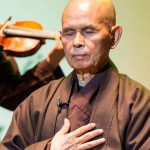In an intriguing recent lecture, scholar of Western Buddhism Jeff Wilson makes the claim that mindfulness is, in fact, Buddhism’s largest single impact on North America. The evidence is more than compelling: from books by Congressman Tim Ryan (A Mindful Nation) and Google’s “Jolly Good Fellow” Chade-Meng Tan (Search Inside Yourself) – shown meeting President Obama – to news reports in nearly every major media outlet and new movements to get mindfulness practice into schools, medicine, police stations, and the military.
Historically, Wilson points out, “mindfulness” comes from the Pali term sati, which can certainly mean mindfulness, awareness, etc, but also means to remember (a connotation of the English term that has largely dropped out of its contemporary “present focused” usage). For instance, a common practice in Buddhism is “mindfulness of the Buddha” wherein one calls to mind a memory of the Buddha and/or his qualities in meditation. And perhaps most importantly, in the Buddhist context, mindfulness is part of the path to awakening, of overcoming the cycle of suffering we are in as ignorant sentient beings. This, Wilson states, is in nice contrast to the “American approach” where Mindfulness = enhancement of life’s joys.
So instead of undertaking mindfulness practice along with a lifestyle that distances one from the activities that perpetuate suffering, an American mindfulness practitioner keeps doing those things, but simply enjoys them more.
Wilson goes on to give a great example of an earlier way that Buddhism adapted itself to a new (for it) society: Japan. Buddhism, as he notes, and researchers know well, has been and still is ever-changing within certain constraints. This is why many statements that begin, “Traditional Buddhism is…” are false or at best misleading. Too often Western practitioners have either an idealized/romanticized or demonized version of some Asian society and the Buddhism practiced there. They then insist that today’s Buddhism is either better than that or fails to live up to it in whatever ways reflect their personal preferences or hobby-horse.
Seeing Buddhism as this flowing stream, we can ask better questions about it. Rather than asking if this or that is true or fake (which may be fun for riling up forces on both sides, generally different factions of practicing Buddhists), we can ask questions like “why is this change occurring?” or “How does this new stream provide benefit in the new society?”
Wilson suggests that the Mindfulness focused form of Buddhism entering into North America emphasizes Mindfulness, Suffering, and Compassion while minimizing previous important teachings such as No-self, Impermanence and Nirvana. And this is just part of the story, the part where Mindfulness is claimed to be a facet of Buddhism. On the other hand, Wilson quotes Jon Kabat-Zinn as writing that:
Mindfulness, the heart of Buddhist meditation, is at the core of being able to live life as if it really matters. It has nothing to do with Buddhism. It has to do with freedom. Mindfulness is so powerful that the fact that it comes out of Buddhism is irrelevant.
With this accepted, mindfulness can be placed in any of a variety of frameworks, from Kabat-Zinn’s medical/therapeutic framework to a more pleasure-oriented and individualistic framework typical of much of American culture. Wilson brilliantly demonstrates this with slide after slide of mindful eating, mindful sex, mindful work, and mindful parenting books, asking the audience if there is anything more American than obsessing over our eating, sex lives, work, and parenting.
Wilson follows with an equally brilliant breakdown of the marketing angle behind Mindful Magazine and the many mindfulness products sold there, focusing on one by a company called BUDHAGIRL: MINDFUL GLAMOUR (that starts at around 1-hour in and I highly recommend it):
In summary, Wilson describes mindfulness as:
- The most popular aspect of Buddhism in America
- Practically oriented, focused on worldly benefits (not transcendence or liberation)
- Focusing on Middle class concerns, affirming the world, body, work, health, and certain desires
- Ever-more disconnected from Buddhism’s past, obscuring certain parts or cutting off historical ties completely
- Commodified into a product in itself or as an add-on benefit to set one product apart from otherwise identical competitors
This is all an amazing amount of food for thought. I think it is certainly true and perceptive to say that mindfulness is the biggest thing Buddhism has brought to N. America and I know that Buddhists are grappling with this (what about ethics? what about wisdom? – the other two parts of the basic 3-fold path). And it’s also important to point out that mindfulness is being used on this spectrum, ranging from very overtly Buddhist-connected to the “Mindful Glamour” label being used to sell jewelry and mindful sex books.
Oh, and there’s an excellent question/point brought up by Jon Kabat-Zinn himself at the end of the talk, don’t miss that.












